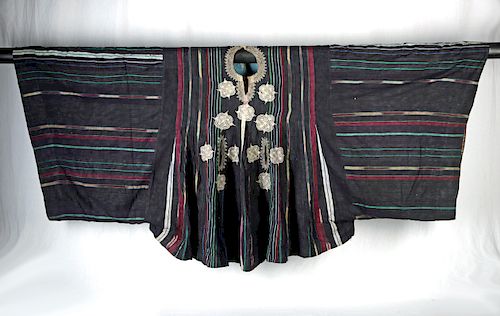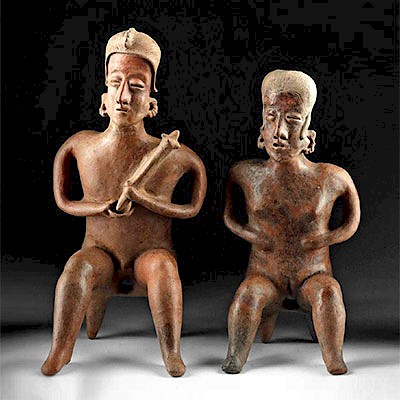Yoruban Chief's Dandogo Robe (Agbada / Riga) - ca. 1900
Lot 157e
About Seller
Artemis Fine Arts
686 S Taylor Ave, Ste 106
Louisville, CO 80027
United States
Selling antiquities, ancient and ethnographic art online since 1993, Artemis Gallery specializes in Classical Antiquities (Egyptian, Greek, Roman, Near Eastern), Asian, Pre-Columbian, African / Tribal / Oceanographic art. Our extensive inventory includes pottery, stone, metal, wood, glass and textil...Read more
Estimate:
$2,000 - $3,000
Absentee vs Live bid
Two ways to bid:
- Leave a max absentee bid and the platform will bid on your behalf up to your maximum bid during the live auction.
- Bid live during the auction and your bids will be submitted real-time to the auctioneer.
Bid Increments
| Price | Bid Increment |
|---|---|
| $0 | $25 |
| $300 | $50 |
| $1,000 | $100 |
| $2,000 | $250 |
| $5,000 | $500 |
| $10,000 | $1,000 |
| $20,000 | $2,500 |
| $50,000 | $5,000 |
| $100,000 | $10,000 |
| $200,000 | $20,000 |
About Auction
By Artemis Fine Arts
May 23, 2019
Set Reminder
2019-05-23 10:00:00
2019-05-23 10:00:00
America/New_York
Bidsquare
Bidsquare : Exceptional Day 2 Ethnographic Tribal Fossils
https://www.bidsquare.com/auctions/artemis-gallery/exceptional-day-2-ethnographic-tribal-fossils-4136
Day 2 of an important 2-day auction featuring exceptional ethnographic art from around the world. Today's sale will feature Pre-Columbian from the ancient americas, Native American, African / Tribal, Oceanic, Spanish Colonial, and incredible Fossils. Artemis Fine Arts info@artemisfinearts.com
Day 2 of an important 2-day auction featuring exceptional ethnographic art from around the world. Today's sale will feature Pre-Columbian from the ancient americas, Native American, African / Tribal, Oceanic, Spanish Colonial, and incredible Fossils. Artemis Fine Arts info@artemisfinearts.com
- Lot Description
West Africa, Nigeria, Yoruba or Hausa, ca. 1900. A most impressive chief's Dandogo Agbada/Babban Riga that is over 100 years old! This voluminous "robe of honor" was created to signify power, influence, and success. Comprised of finely woven cotton threads woven in narrow strips on a hand loom that were skillfully sewn together and demonstrate the most valued patterns such as etu and ikat - and extensively embroidered with elaborate white cotton medallions arranged in a symmetrical design on the bodice, a larger embroidered medallion on the back, as well as complex linear and geometric borders highlighting two pockets and the collar. Size: 46.5" L x 104" W (118.1 cm x 264.2 cm)
This robe is finely woven from hand spun cotton fibers colored with vegetable dyes. The striated pattern of the fabric is displayed on both sides due to the ikat process (see more on this below) and presents striated passages of varying thicknesses as well as colors - deep indigo, sky blue, forest green, burgundy red, black, and beige. Yoruba and Hausa weavers were among only a few weaving groups in West Africa to use the ikat technique, and most examples display a simple alternation of colors within a warp stripe. Usually woven by men, fabric like this was traditionally used to make men's garments known as agbada, women's wraps known as iro, and men's hats known as fila.
Ikat is a technique of dyeing in order to create patterned textiles. The yarns are resist dyed before the fabric is woven. The resist is achieved by binding individual yarns or sometimes bundles of yarns with a tight wrapping that is applied in the desired pattern. Interestingly, the word ikat means "to bind" in the Indonesian language. Once this is done, the yarns are dyed. Oftentimes, the bindings are altered to create a new pattern and the yarns are dyed yet again with another color. This process may be repeated many times to create elaborate, colorful patterns. Once the dyeing is complete, the bindings are removed and the yarns are woven into cloth. In contrast, for other resist-dyeing techniques such as tie-dye and batik, the resist is applied to the woven cloth rather than the yarns before they are woven into cloth. Since the surface design is imbued in the yarns rather than the finished cloth, both fabric faces display beautiful patterns in ikat works like this example.
Provenance: private Poos collection, Overland Park, Kansas, USA; purchased directly from the artist in 2010 - One of the largest privately held quilt and textile collections in the world, the Poos Collection has evolved over 50 years and through extensive travels to allow for original or point of source acquisition. The collection includes international textiles and garments with an emphasis on West African textiles such as adire, aso oke, kente, and ewe woven prestige cloths.
All items legal to buy/sell under U.S. Statute covering cultural patrimony Code 2600, CHAPTER 14, and are guaranteed to be as described or your money back.
A Certificate of Authenticity will accompany all winning bids.
We ship worldwide and handle all shipping in-house for your convenience.
#145217Two of the embroidered medallions near the pockets are missing some threads, but this is very difficult to see. The ikat fabric is in overall excellent condition. Very well preserved given that it is more than 100 years old.Condition
- Shipping Info
-
All shipping is handled in-house for your convenience. Your invoice from Artemis Gallery will include shipping calculation instructions. If in doubt, please inquire BEFORE bidding for estimated shipping costs for individual items.
-
- Buyer's Premium



 EUR
EUR CAD
CAD AUD
AUD GBP
GBP MXN
MXN HKD
HKD CNY
CNY MYR
MYR SEK
SEK SGD
SGD CHF
CHF THB
THB

















